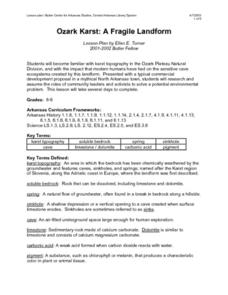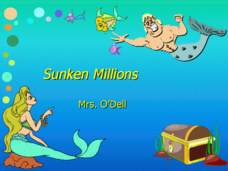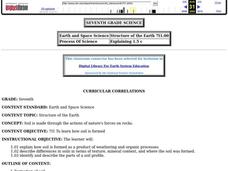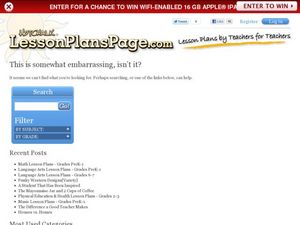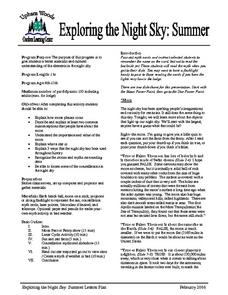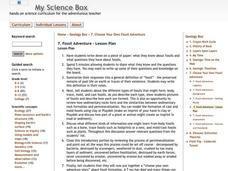Curated OER
How to Teach Students about Acid and Acid Rain
How acidic is your rainwater? Use these lesson plans to get students thinking about how acids affect the environment in which we live.
Curated OER
Moon: NC Summer Tour Lesson 2007
Young scholars investigate craters and marea. In this crater and marea lesson, students conduct an experiment to create craters. Young scholars participate in a dance activity.
Curated OER
Impact Craters: Holes in the Ground!
Students simulate crater formation through a lab activity. In this space science lesson plan, students calculate how much energy is transferred during meteorite impact. They identify different factors affecting the size and depth of...
Curated OER
Surface Water and Groundwater
Students examine distribution of water and minerals. In this surface and groundwater activity, students conduct an experiment with fresh and salt water making hypothesis and drawing conclusions about minerals.
Curated OER
Branches of Science Lesson Plans
Teachers can use branches of science lesson plans to get students excited about science careers.
Curated OER
Neither Wind Nor Rain
Here is another in the interesting series of lessons that use the special State Quarters as a learning tool. This one uses the North Dakota State Quarter. During this lesson, your class learns about the different patterns of erosion, and...
Kenan Fellows
Sustainability: Learning for a Lifetime – Soil
Do great gardeners really have green thumbs—or just really great soil? Environmental scholars discover what makes Earth's soil and soil quality so important through research and experimentation. Learners also develop an understanding of...
Curated OER
Observation and Inference
Assess your young scientists' understanding of the difference between observation and inference with this 20-question multiple choice quiz. It reviews a variety of physics and astronomy concepts, such as solar eclipses and sunspots, the...
Soft Schools
Metaphors: Understanding Comparisons
Here's a metaphor worksheet that asks kids to identify the two things being compared and then to explain the similar characteristics that are being identified.
Curated OER
Ozark Karst: A Fragile Landform
Young geologists become familiar with the Karst Topography in the Ozark Mountains. They study how human activity has affected the cave ecosystem. They conduct a simulation in which a large development is proposed in the area, and they...
Curated OER
Sunken Millions
This PowerPoint provides a game show format with multiple choice questions about fresh and salt water. Topics include sources of water, water geography, uses of water, and the water cycle.
Curated OER
Soil Formation
Seventh graders investigate how soil is formed. They analyze types of soil samples, examine soil using a magnifying glass or microscope, complete a chart, conduct a soil and plant experiment, and construct a soil profile.
Curated OER
Science Review for Grade 5 (5.2)
In this science review for grade 5 (5.2) worksheet, 5th graders answer 25 earth science questions in a standardized test format, including reading maps and diagrams.
Curated OER
Probability: The Study of Chance
Students conduct an experiment, determine if a game is fair, and collect data. They interpret data, then display line graph. They conduct analysis of game for probability.
Curated OER
Parts of an Ecosystem
Fourth graders study the Great Salt lake and the ecosystem that encompasses it. They study the relationship between an individual of a species, a population of that species, a community that includes that population, and the...
Curated OER
Modeling a Soil Profile
In this soil profile worksheet, students use a cup to create the layers of soil using clay, sand, gravel and dirt. Students label each component as either A, B, or C horizon and the bedrock. They answer questions about their model.
Curated OER
Three Clouds Activity
Students understand how clouds are formed. In this cloud activity, students participate in three experiments to make clouds. Students complete activity sheets for each experiment.
Curated OER
Exploring the Night Sky: Summer
Learners explain how moon phases occur. They describe and explain at least two common misconceptions that people have about the moon. Students explain what a star is. They explain 3 ways that the night sky has been used throughout history.
Curated OER
How Big is a Dinosaur?
Fourth graders create enlarged replica of a stegosaurus drawing, using a grid to practice coordinates.
Curated OER
The Oregon Trail
Fourth graders discover the significance of the Oregon Trail in Idaho history. In addition, 4th graders conceptualize the Oregon Trail in relation to their own lives. They engage in a wide variety of curricular activities, culminating in...
Curated OER
Fossil Adventure
Students create a book about the process of a dinosaur becoming a fossil. In this earth science lesson plan, students are taught about fossils and create a book that tells what happened to a dinosaur's bones after they die.
Curated OER
RAINSTICKS
Students create a rainstick from recycled materials and begin learning about the "nature" of the rainforest.
Curated OER
Lesson 1 - What Are Fossils?
Students define and research fossils. In this fossil lesson, students access teacher assigned Internet sites to examine images of fossils. They determine the definition of a fossil and find out how fossils are formed. They also define a...
Curated OER
Climate Change
Students discuss problems associated with a world climate change. They examine how animals would be affected if the world heated up.









